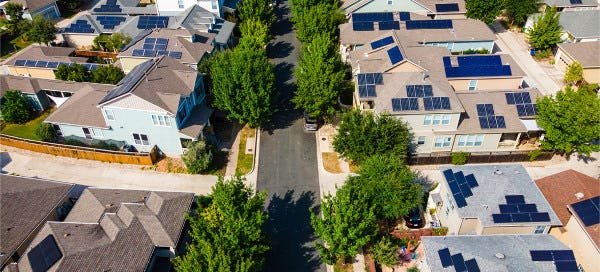Solar powered products have been around for decades. Most of us have used a solar-powered calculator or watch at some point. We continue to benefit from their power every day. As home solar panels have become more popular, a frequently asked question is how much electricity does a solar panel produce?
There are numerous factors affecting how much energy one solar panel can produce. However, you can anticipate approximately 2 kWh per day from solar panels in the United States. This can save Texas homeowners around 40 cents each day on their electricity costs.
That doesn't seem like a considerable amount of savings. But remember that it is just for one day and one solar panel. Having an entire solar panel system installed could save you over $100 a month! So what factors influence how much electricity your solar panels will produce? Keep reading to find out.
How Solar Panels Generate Energy
Solar panels work when particles of light, or photons, remove electrons from their orbit. When the electrons are removed, electricity begins to generate and is captured and stored. This occurs when the sun's light reaches the part of the panel called a photovoltaic cell.
Each solar panel has hundreds to thousands of these cells. Multiple solar panels make up a solar panel system called a solar array. Each array is connected to an existing electrical grid to allow the generated solar energy to be directed appropriately.
Key Terms to Understand
Before you can understand how much power a solar panel produces, you must understand a few basic terms.
Kilowatt (kW) - the measure of electrical power equaling 1000 watts
Kilowatt Hours (kWh) - the measure of electrical energy equal to consuming 1000 watts in 1 hour
Direct current power (DC) - the form of power generated from the solar panel
These items will be discussed in more detail later in this article.
What Is Solar Panel Output?
Solar panels are rated by the amount of DC power produced under ideal conditions. It is expressed in watts (W) and represents how much power you can expect your panels to generate.
Most residential solar panels can produce between 250 to 400 watts, with higher power ratings preferred over lower power ratings. Higher wattage solar panels generate more electricity under the same conditions as lower wattage panels.
Solar Panel Technology
To understand solar panel output further, you need to know what type of panels are used. There are two primary types of solar panels: monocrystalline and polycrystalline.
Monocrystalline panels have more efficient energy production. However, they have higher upfront costs. Monocrystalline panels have better solar output in warmer temperatures or shaded areas. Polycrystalline panels are less efficient, but they are also less expensive. They also work less efficiently in higher temperatures.
Using the right type of solar panel in your home will help you maximize efficiency. You'll fully harness the sun's power with an efficient, high-quality solar panel.
The Most Efficient Solar Panels
People interested in solar panels want to know how much energy they'll produce. But what they don't consider is that not all solar panels are created equal. Many different solar panels are available for purchase, some more efficient than others.
Solar panel efficiency is a crucial part of how much energy they produce. Monocrystalline solar panels are considered to be the most efficient choice for residential and commercial buildings.
Factors that Determine Solar Panel Electricity Production
Before determining how much power a solar panel produces, you need to understand a few key factors. These factors are cell efficiency, solar panel size characteristics, and access to sunlight.
Efficiency and Output of Solar Panels
Today most solar panels can convert around 20% of sunlight into solar energy. This allows them to produce over 400 watts of power. When a panel is more efficient, it creates more energy. More energy equates to more electricity for your Texas home.
Number of Solar Cells and Size of the Solar Panels
The average solar panels are available in two sizes: 60- and 72-cell solar panels. The 60-cell panels have an output between 270 and 300 watts, while 72-cell panels have an output between 350 and 400 watts.
This extra output is because they are larger, allowing an extra row of cells. 72-cell solar panels are typically reserved for larger or commercial buildings.
Amount of Sunlight
Where your home is located can impact how much electricity your solar panels will generate. The more sunlight available in your area, the more electricity your panels will produce.
Other Contributing Factors
Many other things can affect how much electricity your solar panels will produce. For example, the temperature of the panels. As the temperature increases, they become less productive.
Another factor is whether anything is covering the panels. Panels become less efficient if a tree casts a shadow or debris settles on the surface. Even the direction your roof slopes can alter the amount of electricity produced. South-facing roofs typically generate more electricity because of how the sun is positioned in the sky.
Every solar panel has a maximum capacity of electricity it can produce under ideal conditions. Sometimes this is called rated capacity or rated output. Most residential solar panel systems have a capacity between 1 kW and 4 kW.
The time of year also impacts the production of solar energy. During the summertime, there is more sunlight available, resulting in more power. However, remember that solar panels operate on light, not heat. They will still produce plenty of energy during the winter.
Calculating How Much Energy a Solar Panel Produces
Solar panels are rated according to the amount of direct current (DC) power produced under normal conditions. Solar panel output is noted in watts (W) and represents how much power it can produce under ideal conditions. Today, most residential solar panels have a power output rating of between 250 and 400 watts.
Solar pricing is often measured in dollars per watt, making your total solar panel wattage an essential part of the overall cost of your solar system.
You can use the following formula to calculate solar panel output: hours of sunlight x wattage of your solar panel.
So in an area with five hours of direct sunlight each day, your equation would look like this: five hours x 250 watts = 1,250 watt-hours or about 1.3 kilowatt-hours daily. You could estimate that your solar panel output would be between 450 and 500 kilowatt-hours each year for one panel.
How Much Power Does a Solar Panel Produce?
Understanding how much energy a single solar panel can produce is good information to know. However, what may be more helpful is knowing how much solar power your roof can generate.
Every Texas home is different. So the best way to determine the required size of your solar panel system is to look at your electric bill. The average home is 1500 square feet and has a $100 electricity bill each month. You'll need to install a system with 15 solar panels to reduce energy costs.
Fifteen solar panels with an efficiency of 250 watts should produce 18,750 watts or 18.75 kW per day. Since the average home uses about 39 kW hours each day, 15 solar panels would not completely generate enough energy to power your home. You would need to install between 30-40 250 W solar panels.
Will your home's solar panels produce the same amount of energy every time? Not likely. Since factors like the weather influence how much direct sunlight will hit your solar panels, there is no guarantee you'll have the same kWh of electricity generated each month.
Determining How Much Energy Your Solar Panels Produce
Once your solar panels are installed, you'll have an accessible meter in your home. This meter records how much electricity your solar system produces and how much is sent back to the grid.
Depending on the manufacturer, you may also have access to an app on your smartphone that will allow you to view the performance levels of your solar panel. You could also view this information online from your computer.
To maximize the electricity produced by your solar panels, use your appliances during the day rather than at nighttime. This is because the panels generate energy during the daylight hours. Furthermore, you should convert to energy-saving lightbulbs and turn off electronic devices when not in use. Leaving them on standby will still use valuable energy.
Powering Your Home with Solar Energy
Now you better understand how much solar electricity you can expect from a single solar panel and an entire solar panel system. However, installing a solar system does more than just help the environment by using renewable energy; it saves you money.
When you use electricity produced by rooftop solar panels, you aren't using the services of a utility company. This means they do not have to charge you. If you can install enough solar panels to cover all of your electricity needs, you can save between $90 and $100 every month.
Of course, this is only an estimate. As you now know, several factors contribute to how much electricity your solar panel system produces.
Frequently Asked Solar Panel Energy Questions
Every home requires more than one solar panel to provide adequate power. However, each residence is unique and requires a different solar panel output. Here are some frequently asked questions regarding how much energy a solar panel system will generate.
How Many Solar Panels Are Required to Generate 1000 kWh Every Month?
Weather conditions can influence this answer. Under ideal sunlight conditions and using the average solar panel, most homes need 27 solar panels to generate 1000 kWh monthly.
How Much Energy Do Solar Panels Produce Hourly?
Most solar panels will produce between 170 to 350 watts every hour. But this depends on the direct sunlight and weather conditions. It averages out to 0.17 kWh to 0.35 kWh per solar panel.
Can You Increase the Output of Your Solar System?
No, there is no way to increase solar panel output or the efficiency of your solar panels. They are designed to achieve a certain level. However, you can help them perform as efficiently as possible by routinely cleaning dust and debris from the surface. When they are dirty, they will work less efficiently.
Now that you understand how solar panel output is calculated and recognize the factors affecting it, you may be ready to continue your solar journey. Contact local solar installers to gather information about the costs and schedule a home inspection.
Take Advantage of Your Solar Panel Output with Rhythm!
Texans have options. One of those options is your electricity supplier, and at Rhythm, we want to be your supplier. Your solar panels will likely produce more energy than you can use. So what happens to that extra renewable energy? It can go right back into your pocket.
Additional energy generated by your solar panels can be sent back into the Texas power grid to help other members of your community with their power needs. Then, as a customer at Rhythm, we pay you!
We'll send you buyback credits on your monthly statement when you participate in our Rooftop Solar Buyback Plan. You can apply it toward your energy costs, leaving more of your hard-earned money in your bank account.




